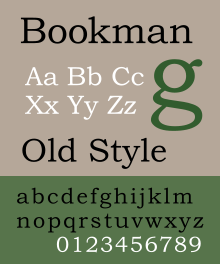Bookman Old Style
 |
|
| Category | Serif |
|---|---|
| Classification | Transitional |
| Designer(s) | Alexander Phemister Chauncey H. Griffith Ed Benguiat |
| Foundry |
Miller & Richard Bruce Type Foundry American Type Founders Lanston Monotype |
| Date created | c.1858 |
| Design based on | Old Style Antique |
| Variations | Antique Old Style No. 7 Old Style Antique #310 New Bookman Meola Bookman ITC Bookman Bookman Oldstyle MT Bookman JF Bookmania |
| Also known as | Bartlett Oldstyle Revival 711 |
| Shown here | Bookman Oldstyle by Monotype Imaging |
Bookman or Bookman Old Style, is a serif typeface. A wide, legible design that is slightly bolder than most body text faces, Bookman has been used for both display typography and for printing at small sizes such as in trade printing, and less commonly for body text. In advertising use it is particularly associated with the graphic design of the 1960s and 1970s, when revivals of it were very popular.
Bookman evolved from fonts known as Old Style Antique, which are bold derivatives of the "Modernised Old Style" design created by Alexander Phemister around the 1850s for the Miller & Richard foundry. These have letterforms similar to those of the eighteenth-century typeface Caslon, with a more even and regular structure, a wide and tall lower-case, and little contrast in line width. Bookman is much bolder than the original Modernised Old Style, to which it was intended to be a bold complement, almost to the point of being a slab serif. The 1924 textbook Introduction to Advertising describes Bookman as "simple, masculine and leaves the impression of reliability without heaviness".
The ancestor of Bookman Old Style is Miller & Richard's "Old Style", cut by Alexander Phemister. Often described as "modernised old style", it is a redesign of "true old-style" serif faces from the eighteenth century such as Caslon. Like them, it has sloping top serifs and an avoidance of abrupt contrasts in stroke widths. The lower-case letters are quite wide and the x-height (height of lower-case letters) is quite large. Widely resold and pirated, it became a standard typeface and helped to create a genre of a wide range of loose revivals and adaptations of the Caslon design, visible in the wide-spreading arms of the T and the sharp half-arrow serifs on many letters. (Ronaldson Old Style by Alexander Kay (1884) was another, as was Phemister's own later Franklin, created after he had emigrated.)
The direct ancestor of Bookmans were several fonts from around 1869 named "Old Style Antique" intended as a bold complement to the original Old Style face. "Antique" was a common name given to bolder typefaces of the time, now often called slab serifs, and identifies the aim of creating a complementary bolder design on the oldstyle model for uses such as emphasis and headings. However, the old style antique fonts also became used for extended body text use. Although Old Style Antique faces were bolder than Old Style, the difference was not great enough that they could not be used for body text.
...
Wikipedia
